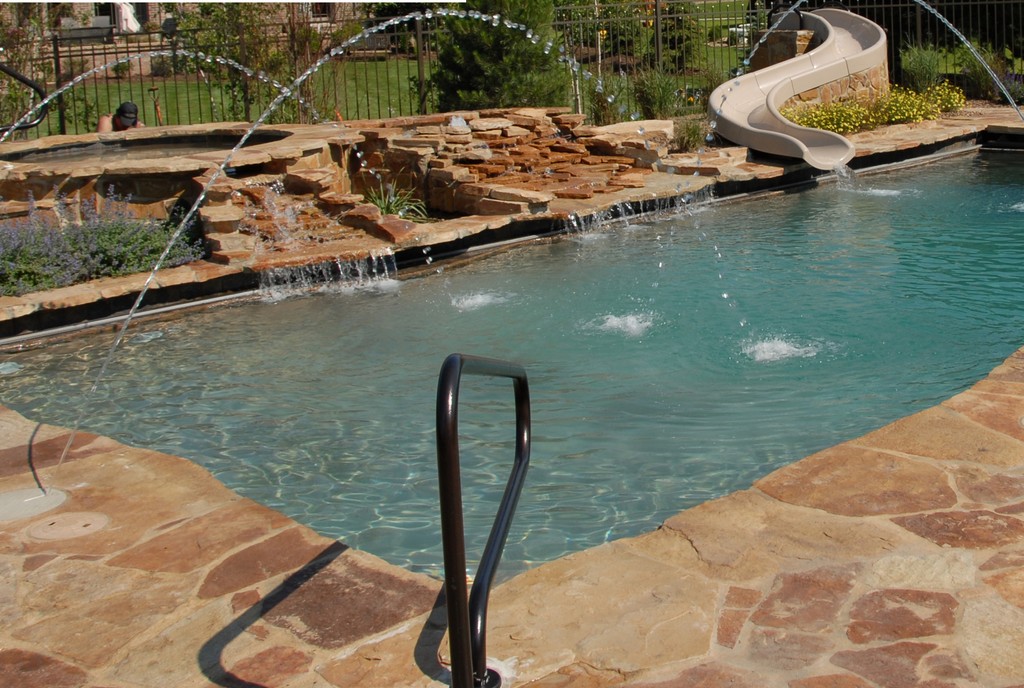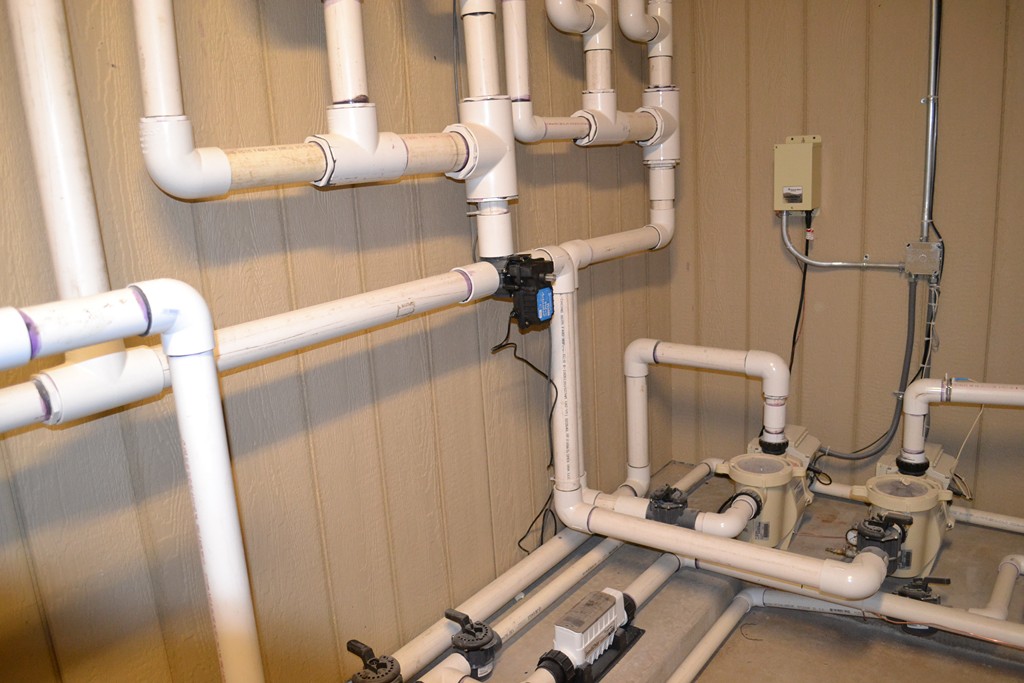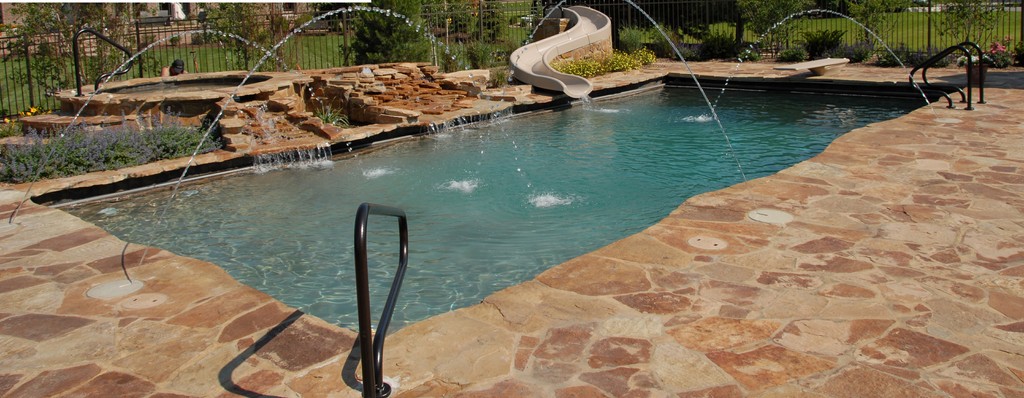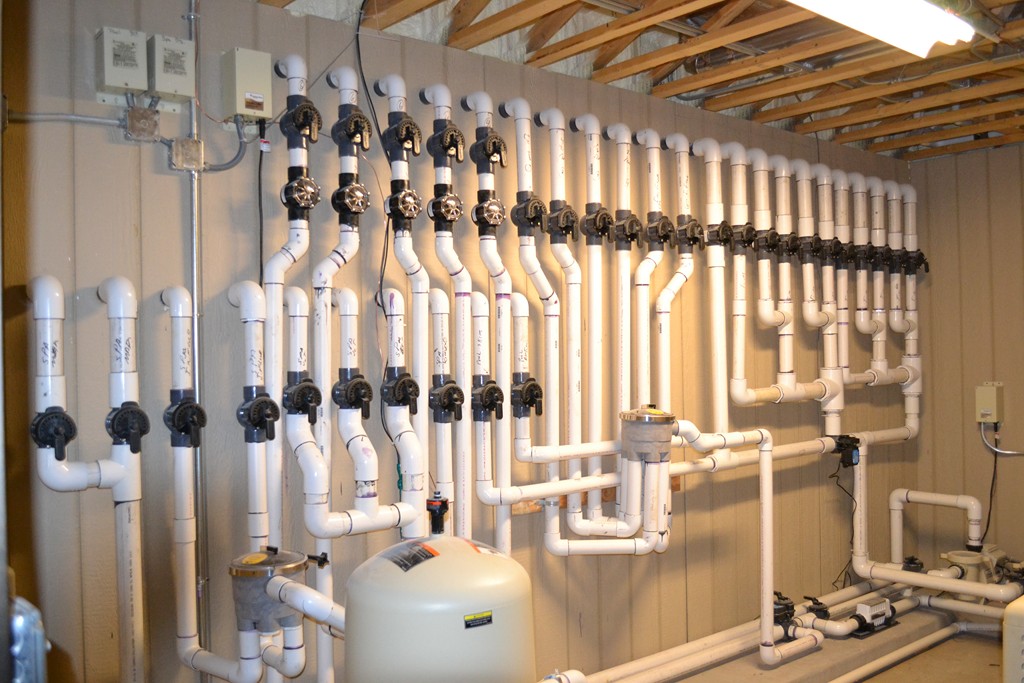Avoiding ‘Dead Spots’

Just the term “dead spot” sounds bad on its own – and that’s probably a good thing, because it’s definitely something every watershaper should try to avoid.
That can be tough these days, given the complex shapes of modern swimming pools and their multiple curves, inlets, grottos, vanishing edges, beach entries, tanning shelves and various other features that complicate the interior contours of the shell.
To get the job done, you need to select the proper pump, determine the optimal flow rate and position outlets in such a way that complete circulation is achieved. And if you accomplish all that, it gets even better, because you’ll end up carving out some long-term energy savings for your clients.
With all of that in mind, let’s focus on how to choose a pump of the right size and speed for a variety of pools. Along the way, we’ll cover a few tips and rules of thumb that will result in better water flow and reduced energy consumption.
SIZING THE PUMP
Putting things in scientific terms, the affinity laws tell us that the power demanded by a pump is proportional to the cube of the flow rate. So if the pump’s flow rate is doubled, then its power demand increases by a factor of eight. This is why it’s so important to find the smallest available pump that is capable of completely turning over the pool water in an acceptable amount of time.
Doing these calculations is relatively simple with a plain, featureless pool, but if the watershape comes with any auxiliary features (fountains, waterfalls, spray pads) and you want them to run off the pool’s main pump (as watershapers often do), the selection process becomes more complicated and critical.
In some areas, of course, codes require these installations to have multi-speed pumps or, in some cases, separate pumps for each additional load. (This may complicate the plumbing program, but it makes pump selection a bit easier.) But in areas where these stringent codes don’t apply, there’s a lamentable tendency among some designers, engineers or builders to shortcut the process and select a pump that’s 20 to 40 percent bigger than is nominally required – basically overkill to make certain the pump can handle the job.
| The complexities of modern watershapes – pools that, for example, might include leaping jets, waterfalls, slides, grottoes, tanning shelves and more – impose a burden on designers and builders to make certain their circulation systems work as well as they should. |
Here’s a better, less random selection process:
[ ] Determine the flow rate in gallons per minute (GPM). [ ] Calculate the total dynamic head (or TDH – that is, the pressure head difference between the inlet and outlet of the pump) to account for friction loss. (Adding another 20 feet of head to account for a dirty filter is an option.) [ ] Refer to pump performance curves to guide selection of the appropriate unit. [ ] Determine the required horsepower of the pump by plotting GPM against TDH. If the plotted point falls between two pump sizes, select the next larger pump size in terms of horsepower (hp). [ ] Do not oversize the pump. That is, choose the best pump available for the pool’s flow-rate requirements – and avoid the temptation of installing a 20-hp pump where a 10-hp pump will suffice just because that’s what you have on hand or are a fan of the overkill approach mentioned above). And if the preferred pump type does not provide a proper fit, consider a different pump type. [ ] Verify that the selected filter can handle the system’s flow rate and be sure the minimum backwash flow rates can be achieved.This process should be familiar to all watershapers, but as you might imagine, following these steps with care increases in importance proportionately with the complexity of a given pool.
DODGING DEAD SPOTS
The ambition of all watershapers should be to avoid the creation of spots within a pool that are effectively beyond the reach of the circulation system – little corners, recesses or shallows where the flow pattern established for the pool is less than completely effective and leaves them out of the picture.
| The equipment rooms of today’s watershapes are starting to look like the engineering rooms of submarines, but when well designed and managed, they can still be run by a small complement of pumps – if, of course, the pumps are right for the job. |
There are two solid ways to make sure a swimming pool is designed and will circulate in such a way that these dead spots are eliminated, no matter what insets, curves, grottos, shelves, fountains or slides it might feature.
 First, it’s about properly balanced plumbing: The key to a well-balance plumbing system and a properly circulating pool is a hydraulically sound plumbing layout on both the suction and return sides of the system. Taking larger pipe sizes to the pool from the equipment pad and then breaking them down to smaller sizes in balanced ways around the pool will ensure that you have proper circulation throughout the entire body of water.
First, it’s about properly balanced plumbing: The key to a well-balance plumbing system and a properly circulating pool is a hydraulically sound plumbing layout on both the suction and return sides of the system. Taking larger pipe sizes to the pool from the equipment pad and then breaking them down to smaller sizes in balanced ways around the pool will ensure that you have proper circulation throughout the entire body of water.
Second comes proper placing and directing of return lines: When bringing water back to the pool after it passes through the filtration system, the objective is to make sure it returns to the pool as evenly as possible.
Too often, contractors fall back on habit and install suction and return lines in similar patterns for every project. That may be efficient in terms of construction, but it can result in great inefficiencies with the circulation system. Instead, contractors should align return lines throughout the pool in view of the pool’s individual characteristics and in such a way that the water moves in a circular pattern around the pool’s perimeter with no dead spots. That flow should also pass in front of skimmers in order to help them do their job of removing debris from the pool’s surface.
One way to enhance balance and efficiency is the simple step of running the return-line plumbing past the outlet and then capping the end of the line. This reduces turbulence within the outlet, enhancing flow dramatically and helping the outlets that are farthest away from the pump perform as efficiently and effectively as those closer in.
In larger pools, another path to efficiency has to do with setting up multiple circulation zones, dividing the plumbing into two or three or more sections and rigging each with its own pump. If, for example, you’re working on a 20-by-40-foot pool with a grotto and a waterfall and a slide and a sundeck with a fountain and a cuddle cove/play area, in this approach you would divide the shallow end into one zone, the mid-section into a second zone and the deep end area into a third zone, with various pumps and plumbing sized accordingly.
SPEED LIMITS
A factor we haven’t considered so far is pump speed. Historically, pool pumps with induction motors operate at only one or two speeds and typically draw more energy than is required to circulate the pool’s water. For the most part, these units constantly operate at high speed to perform their most demanding jobs, such as running a waterfall or pool cleaner. That’s problematic, because if all the pump does most of the time is circulate water through the filtration system, it could be running at a much slower speed to do so.
Two-speed pumps address this issue to a limited extent; a better option comes in the form of variable-speed pumps. Rather than operating at one speed or at a high or low speed, variable-speed pumps are programmed to run at the correct speed to meet the needs of the various systems in operation around the pool. This means that the pump operates at a low speed when basic circulation is all that’s being accomplished – but ramps up to meet the needs of a slide or a fountain or a waterfall, and then only at the required level and no more. This results in a dramatic drop in energy consumption as well as long-term reductions in operating costs.
Doubling back on the selection process for a moment, if you run into a situation where a big, high-horsepower pump is really the only option, the use of a variable-speed drive serves to optimize the big pump’s performance while delivering cost savings that would be out of reach without this technology.
Some variable-speed pumps can also be programmed to achieve a turnover time of exactly six hours, no matter whether the filter is clean or dirty. Thus, the motor speed, power and energy levels are reduced when the filter is clean – so there’s no more upsizing a pump to accommodate worst-case operating conditions. Some units can also be programmed to deliver the required flow rate for each programmed task, meaning fountain performance will not be affected even if the filter needs a cleaning.
The availability of these various pump types gives watershapers plenty of options when it comes to developing the right system for a client’s pool. The key to avoiding dead spots is careful development of the plumbing plan, particularly with respect to placing return outlets. Beyond that, savings start to build when the right-size pump is selected for the job at hand and used to best advantage to keep the water circulating – and your client smiling.
Mike Fowler is the commercial marketing and sales manager for Pentair Aquatic Systems in Sanford, N.C. He has been with Pentair since 1992, having starting his career in the technical services department at Purex Pool Products. He can be reached via e-mail at [email protected].












